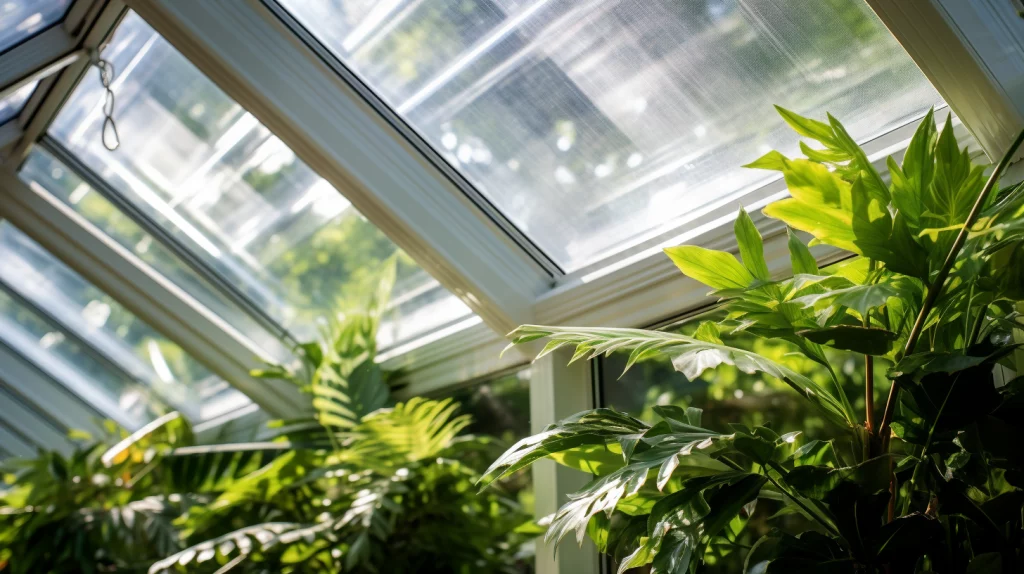Are you considering a polycarbonate roof for your home or business?
Choosing a roofing material for a conservatory can be a big decision, and understanding the ins and outs of polycarbonate roofs is important before rushing to make a selection.
From durability to insulation, there are several factors to consider when opting for this type of roofing.
In this blog, we’ll look into the key questions surrounding polycarbonate roofs, guiding you through important considerations and long-term costs.
Whether you’re a homeowner looking to enhance your property or a business owner planning a construction project, we aim to bring a better understanding of the options and assist you in making informed decisions about whether polycarbonate is the right roofing solution for you.
What is a polycarbonate conservatory roof?
Polycarbonate is a versatile thermoplastic that has traditionally been a popular choice for conservatory roofs. Known for its durability and transparency, polycarbonate is a lightweight and impact-resistant plastic. It is now a common choice for conservatory roofs due to its cost-effectiveness.
Its difference from conventional roofing materials meant it could be offered as an affordable alternative, disrupting the established norms in the construction industry.
Traditionally, roofing materials were chosen based on their ability to provide structural integrity and protection from the elements. However, polycarbonate introduced a material that not only met the basic criteria but also brought some new benefits.
The practicality of polycarbonate in roofing applications became evident as it provided a lightweight yet robust solution, catering to the evolving needs of developing construction.
This material’s strength allowed for better structural integrity, offering added resilience against environmental factors. Its translucency also became a popular feature, allowing natural light into interior spaces.
In addition to these, one of the most noticeable aspects of polycarbonate was its affordability. In a market where construction costs often played a determining role in material selection, polycarbonate presented a cost-effective alternative.
This economic advantage made it an appealing choice for a broader spectrum of projects, allowing access to a roofing material that was fairly functional and financially affordable.
The widespread use of polycarbonate in roofing applications can be attributed to its versatility and uniqueness at the time.
As builders and architects looked for materials that could improve both functionality and look, polycarbonate emerged as a contender, giving roofing options and contributing to a more sustainable and innovative approach to construction.
Over time, as more advanced technology has arrived on the scene, many have looked to upgrade their polycarbonate roofs to enjoy the further benefits brought by new options.
Different types of polycarbonate roof
Clear polycarbonate
Clear polycarbonate is chosen for its ability to let in natural light, creating a well-lit and open atmosphere. Its cost-effectiveness is a noted advantage for those on a budget.
However, it’s key to acknowledge potential drawbacks. Clear polycarbonate may be susceptible to scratches and impacts, needing consistent maintenance to remain clear. Also, its transparency may mean less privacy compared to alternative options.
Tinted polycarbonate
Tinted polycarbonate is chosen for its ability to reduce glare and provide shading, enhancing comfort. It offers UV protection and adds aesthetic appeal to the space.
However, it reduces natural light transmission and may require regular cleaning. Privacy considerations should be taken into account, making it a balanced choice between functionality and aesthetics.
Multi-walled polycarbonate
Multi-walled polycarbonate offers increased insulation, making it ideal for diverse climates. Its layered construction creates an effective thermal barrier, contributing to energy efficiency and consistent indoor temperatures. Additionally, it offers increased durability and UV protection compared to regular polycarbonate.
However, it may be comparatively more expensive, require precise installation, and demand occasional maintenance. The decision to opt for multi-walled polycarbonate involves weighing its insulation benefits against potential cost considerations and installation complexities.
Advantages of polycarbonate roofs
Polycarbonate roofing comes with several benefits, making it a popular choice among homeowners. Not only is it lightweight and easy to install, but it also offers a degree of UV protection. In addition to this, it is also a much more affordable option versus traditional construction materials.
Lightweight and easy to install
Polycarbonate is significantly lighter than glass, simplifying the installation process. This characteristic also reduces the load on the conservatory structure. Depending on your type of conservatory, polycarbonate is generally versatile and can be installed quickly.
UV protection and thermal insulation
Polycarbonate roofs often feature UV protection, shielding you and your furniture from harmful rays. They also provide a level of thermal insulation that can help regulate temperatures within the conservatory.
Cost-effectiveness compared to other materials
One of the key advantages of polycarbonate is its cost-effectiveness. It offers a balance between basic performance and affordability, making it an attractive option for those on a budget.
Variety of designs and aesthetic appeal
Polycarbonate roofs are available in various designs and styles. Whether you prefer a clear, tinted, or multi-walled option, you can find polycarbonate roofs in a range of styles to complement your aesthetic preferences.
Disadvantages of polycarbonate roofs
While polycarbonate roofs have numerous advantages, it’s essential to be aware of potential drawbacks. For example, because polycarbonate is a soft material it is prone to impact damage and scratches. Also, you may find that rain or hail creates a bit of a noise, and there are some issues when it comes to energy efficiency.
Susceptibility to scratches and impact damage
Polycarbonate can be prone to scratches, especially if it comes into contact with abrasive materials. There is also the chance of more severe damage from impacts or falling objects that may cause damage that requires replacement.
Noise issues during rain or hail
The sound of rain or hail hitting a polycarbonate roof can be louder compared to other materials. This noise factor is an important disadvantage to consider, especially if you value a quiet and peaceful indoor environment.
Potential for discolouration
Exposure to harsh weather conditions, such as intense sunlight, may lead to discolouration over time. While this doesn’t affect the structural integrity, it can impact the look of the roof.
Thermal expansion and contraction challenges
Polycarbonate roofs may experience thermal expansion and contraction, which can ultimately lead to issues like leaks if not properly installed and maintained.
Maintenance requirements
Regular cleaning and maintenance are essential to prevent issues like scratches, discolouration, and the accumulation of debris on the roof surface.
The best replacement for polycarbonate conservatory roofs
If you’re considering a polycarbonate conservatory roof replacement, there are a couple of options available, with the two main choices being glass roofing and acrylic roofing.
Glass Roofing
Glass roofing presents a set of distinctive characteristics that cater to both aesthetic preferences and functional considerations.
The advantages of opting for glass roofing include its ability to improve the overall aesthetics of a space, providing a sleek and modern appearance that complements various architectural styles.
In addition to its visual appeal, glass roofing offers improved insulation properties when compared to certain polycarbonate options.
This enhanced insulation helps to maintain a comfortable indoor temperature, making it suitable for year-round use.
However, it is essential to consider the potential drawbacks associated with glass roofing.
One notable aspect is the higher cost associated with the material and installation, making it a more substantial investment compared to some polycarbonate alternatives.
Also, glass roofing may pose a risk of heat loss during colder months, potentially impacting the overall thermal efficiency of the space. Despite these considerations, it can be a popular choice for those willing to invest in both form and function.
Glass roofing pros:
- Enhanced aesthetics.
- Better insulation compared to some polycarbonate options.
Glass roofing cons:
- Higher cost.
- Potential for heat loss in colder months.
Acrylic Roofing
While acrylic roofing shares some similarities with polycarbonate, it also has distinct characteristics; For example, it is lightweight and durable, and it is also UV-resistant.
However, there are a couple of main differences. Acrylic tends to be more expensive than polycarbonate. Also, polycarbonate offers better impact resistance.
When comparing acrylic roofing to polycarbonate, it’s key to look at both their shared traits and distinctive features.
In terms of similarities, both materials are known for their lightweight nature and durability, ensuring they last through various weather conditions. They also both hold some level of UV-resistant properties, safeguarding the roofing from the harmful effects of prolonged sun exposure.
However, the differences between acrylic and polycarbonate roofing set them apart in specific aspects. Acrylic roofing, while delivering aesthetic appeal and better clarity, tends to come with a higher price tag compared to polycarbonate alternatives. This cost difference is an important factor for individuals making decisions based on budget considerations.
CosyPanels
Another option to consider is CosyPanels, a revolutionary and efficient alternative to a polycarbonate conservatory roof that offers a distinctive range of advantages.
First and foremost, its lightweight design sets it apart, providing a practical and easy-to-handle solution during both installation and ongoing use. Their conservatory panels are made from a lightweight UPVC wrapped around a layer of high-density insulation.
This aspect not only streamlines the installation process but also contributes to the overall structural integrity of the conservatory.
One of the standout features of CosyPanels is its excellent insulation properties. By incorporating these panels into the conservatory roof, homeowners can experience improved thermal efficiency, maintaining a comfortable and regulated indoor temperature throughout the year.
This high level of insulation also helps in reducing energy consumption – leading to long-term savings.
CosyPanels also effectively tackles the issue of condensation, a common concern in conservatories. The panels’ design and composition work in tandem to minimise condensation buildup, creating a drier and more comfortable environment within the space.
This reduction in condensation not only contributes to improved comfort but also helps in preserving the integrity of the conservatory structure over time.
While CosyPanels present a range of benefits, it’s important to note that, like any solution, they may not be universally suitable for all types of conservatory roofs. The compatibility of CosyPanels should be checked so an assessment can be made of the specific design and requirements of the conservatory in question.
Make the right choice for your conservatory roof replacement
Choosing the right conservatory roof replacement involves weighing up various factors:
- Climate: Consider the climate in your area and choose a roofing material that can withstand local weather conditions. If your conservatory gets cold or noisy from lots of rainfall, you may need to opt for a highly insulated option.
- Usage: Think about how you intend to use your conservatory. Will it be a year-round living space or a seasonal retreat? If you intend to use it as a full-time extension of your property, then using higher quality materials, such as Cosy Panels thermal roof panels, might be a better option for you.
- Budget: Evaluate the costs associated with different roofing materials and choose one that works with your budget. Although polycarbonate may appear to be the cheapest option at the outset, costs that may be incurred through replacement, cleaning, and maintenance all add up and make it less cost-effective than other alternatives.
The importance of professional installation and quality materials
Regardless of the roofing material you choose, professional installation is crucial. Ensure that qualified contractors handle the installation to guarantee proper fit, weatherproofing, and compliance with building standards.
Prioritise high-quality materials to enhance the longevity and performance of your conservatory roof.
CosyPanels, with their lightweight design and excellent insulation properties, provide a durable and cost-effective solution. Backed by a full 10-year guarantee, they offer peace of mind and long-term savings.
Selecting the right roofing for your conservatory requires thoughtful consideration of factors like budget, style, and practicality.
Whether you’re drawn to the efficiency and aesthetics of CosyPanels, the classic appeal of glass, or other materials such as polycarbonate, each choice has to be carefully assessed.
Tailoring your decision to the specific needs of your conservatory ensures a practical and visually pleasing outcome. As you enter this decision-making process, explore the options, seek expert advice, and choose a solution that aligns with your vision for a functional, aesthetically pleasing, and enduring conservatory space.
Ready to enhance your conservatory with a new roof?
Book a free quote with CosyPanels today and see what you can achieve when transforming your conservatory.


